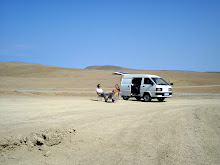Friday 30 November 2007
Friday 23 November 2007
Syrian reflexions
We left Syria and are again in Turkey. Syria of course left a lot of impressions and here are some:
The first town we visited was Latakia on the coast, and it was not at all what I expected. Another muslim country I thought, and a very nondemocratic one again, this will surely be very conservative. I was wrong. Latakia is a rich and rather Christian part of Syria and on what is called "the American Street" we found expensive cars, bars and cafés filled with rich young people showing off the latest -not at all muslim - fashion.
And then we came to Aleppo, again a surprise. Because here were all the conservative muslims. Here we saw the most women with covered faces. But Aleppo also had the friendliest people that we met in Syria, maybe because there are not as much tourists here as in Damscus? The bazaar is relaxed and the sellers don´t hunt you down or try to tripple the price because you are a tourist. Another sign of a majority of local customers is what they sell. Less waterpipes and scarves and more sheepsheads and some kind of white, transparent gel that I still don´t know what it is.
People were - like almost everywhere we whent - extremely helpful and welcoming. Almost to much actually, I´m getting tired of explaining where I´m from and hearing about someones uncle in Sweden and so on... The Syrians speak very good english, even the juice seller on the street, and they are very quiet about politics. Much more than in Iran people seemed scared to talk about the president. The only thing they mentioned to us as a problem was the refugee situation. Some claim that more than two millon Iraqis are living in Syria, I think many of them on the street.
The first town we visited was Latakia on the coast, and it was not at all what I expected. Another muslim country I thought, and a very nondemocratic one again, this will surely be very conservative. I was wrong. Latakia is a rich and rather Christian part of Syria and on what is called "the American Street" we found expensive cars, bars and cafés filled with rich young people showing off the latest -not at all muslim - fashion.
And then we came to Aleppo, again a surprise. Because here were all the conservative muslims. Here we saw the most women with covered faces. But Aleppo also had the friendliest people that we met in Syria, maybe because there are not as much tourists here as in Damscus? The bazaar is relaxed and the sellers don´t hunt you down or try to tripple the price because you are a tourist. Another sign of a majority of local customers is what they sell. Less waterpipes and scarves and more sheepsheads and some kind of white, transparent gel that I still don´t know what it is.
People were - like almost everywhere we whent - extremely helpful and welcoming. Almost to much actually, I´m getting tired of explaining where I´m from and hearing about someones uncle in Sweden and so on... The Syrians speak very good english, even the juice seller on the street, and they are very quiet about politics. Much more than in Iran people seemed scared to talk about the president. The only thing they mentioned to us as a problem was the refugee situation. Some claim that more than two millon Iraqis are living in Syria, I think many of them on the street.
Wednesday 21 November 2007
Golan Heights
A big piece of Golan Heights in the south-west of Syria has been occupied by the Israelis in the 1967 war. To see how much land this involves, we drove down the road with Gefar and Ebba to Quneitra. It is a Syrian town that the Israelis systematically destroyed when they retreated from the 1973 ceasefire lines.
Far down the road, pass the UN checkpoint, we came to the ghost town of Quneitra, greeted as usual by an Hafez Assad statue. There we were stopped by a moustached security man in leather jacket and a Kalashnikov over his shoulder. One can see these men in front of every governmental building in the country. We got an official escort wearing Adidas training suit. He took us first to a hospital, then to an orthodox church, a school, and a mosque. The remains of the hospital have become an exhibit demonstrating the approach of Israeli soldiers. The sheet of metal attached to the building says ˝Golan Hospital. Destructed by Zionists and changed it to firing target˝. All buildings we saw have one thing in common. They are completely shelled and partially bulldozed, painted with odd graffiti in Cyrillic saying Chechnya. Our escort didn’t know the graffiti’s origins. I found comparison appropriate. Grozny must look the same; although Russians would not allow anyone see it.
On the Syrian front line, so close that one could see Israelis farming a field, I asked a lieutenant commanding the outpost if he thinks they will ever get an occupied land back. He said, God willing, the land beyond this town, from the heights of Mount Hermon boasting high-tech Israel’s radar stations down to the Sea of Galilee, is all supposed to be liberated one day.
Far down the road, pass the UN checkpoint, we came to the ghost town of Quneitra, greeted as usual by an Hafez Assad statue. There we were stopped by a moustached security man in leather jacket and a Kalashnikov over his shoulder. One can see these men in front of every governmental building in the country. We got an official escort wearing Adidas training suit. He took us first to a hospital, then to an orthodox church, a school, and a mosque. The remains of the hospital have become an exhibit demonstrating the approach of Israeli soldiers. The sheet of metal attached to the building says ˝Golan Hospital. Destructed by Zionists and changed it to firing target˝. All buildings we saw have one thing in common. They are completely shelled and partially bulldozed, painted with odd graffiti in Cyrillic saying Chechnya. Our escort didn’t know the graffiti’s origins. I found comparison appropriate. Grozny must look the same; although Russians would not allow anyone see it.
On the Syrian front line, so close that one could see Israelis farming a field, I asked a lieutenant commanding the outpost if he thinks they will ever get an occupied land back. He said, God willing, the land beyond this town, from the heights of Mount Hermon boasting high-tech Israel’s radar stations down to the Sea of Galilee, is all supposed to be liberated one day.
There’s that man again
In Syria, there’s one face that stares at you everywhere: that of the president, Basher Al-Assad. Every town and city across the country is filled with pictures in which the president appears slightly moustached, with or without sunglasses, with his doctor outfit or in the camouflage uniform of the Syrian army. However, the most frequent image is the one of his silhouette with sunglasses, in black or silver, sticked on car’s windscreens. Shlakiyah got one as well. When we drove from Aleppo to Hama we played a Basher game. The one who would notice him and say Basher first would gain a point. In the final score Anna won by two Bashers ahead of me. Despite the fact that we drove mainly on the highway, we caught sight of 146 Bashers.
And so will the face of his father stare, the late president Hafez Al-Assad, whose giant statues and busts appear at the gates of Syria’s towns and cities. It’s said that the idea of presidential adoration came back with Hafez after a visit to North Korea. Moreover there would be trios. Trios of Hafez and Basher: with the departed son Basil, or with Mahmoud Ahmedinejad, or with lately favourite head of Hizballah, Sheikh Hassan Nasrallah.
And so will the face of his father stare, the late president Hafez Al-Assad, whose giant statues and busts appear at the gates of Syria’s towns and cities. It’s said that the idea of presidential adoration came back with Hafez after a visit to North Korea. Moreover there would be trios. Trios of Hafez and Basher: with the departed son Basil, or with Mahmoud Ahmedinejad, or with lately favourite head of Hizballah, Sheikh Hassan Nasrallah.
The Birds
A few years ago, during sitting on my favourite balcony in Amman at Al Rashid, I noticed a flock of pigeons circling over the city roofs. They looked mysterious enough to get me interested in finding out more. I climbed some roofs back then and found out that training pigeons is one of the most famous hobbies in the Middle East. In Damascus it was time to climb a roof again. It was not as easy this time in view of the fact that it is now illegal to keep the birds due to the last bird flu epidemic. Nebir is a bird fancier for already thirty years. It is addictive, as smoking water pipes, he said. The pigeons owners buy their pets on a special bazaar open on Friday. A pigeon can cost anything between 15-150 EUR. Nebir’s most precious cock pigeon is oddly called the German. His feet are adorned by plastic jewellery. Nebir spends at least two hours a day on his roof. Sometimes more, if he has to treat or bath his pigeons in salty water. Luckily he has enough time for he is not married.
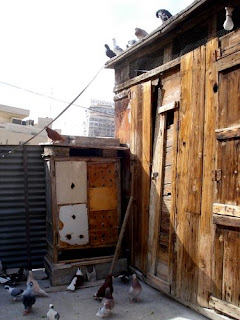
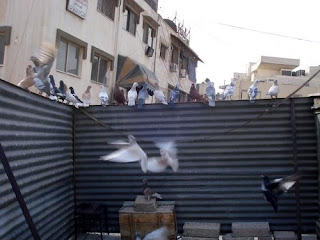

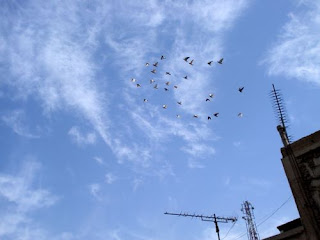
Ya Hussein
The Umayyad mosque is one of the most remarkable buildings of Islam and the most important pilgrimage site in all of Syria. The absolute majority of pilgrims are Iranian. They are the first to be noticed in the old city. Hundreds of women in black chadors are filling up already overcrowded narrow lanes of the bazaar leading to the mosque, loudly haggling in Farsi over rather unusual material goods. But all of them here are after spiritual goods. The flocks of pilgrims visit the main praying hall first. There they would sit on the carpets and attend communal prayer with a mullah. Looking somewhat out of the place there is the shrine of John the Baptist. It is well lit with green neon lights, ornamented with plastic flowers, and supposedly contains his head. However, this is only one of several claimed places for the mentioned relic and unless the saint had multiple heads, the authenticity of cage’s content has to be questioned. 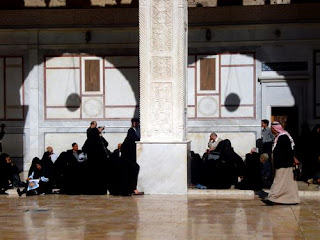


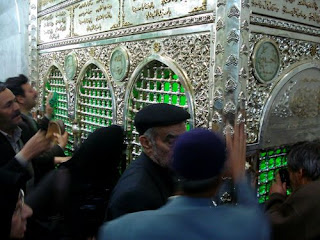
The other corner of the mosque contains even more holy shrine and a claimed head, this one allegedly belonging to Imam Hussein, the grandson of the Prophet Mohammed. He was martyred by the Umayyads at Kerbala, but whether or not his head ended up here is uncertain as well. Not for the pilgrims. I got caught in a stream towards his shrine, surrounded with fine metal, neon green. This is a place of deep mourning; pilgrims crying while simultaneously taking photos of the cage with their cell phones. While I was contemplating the procession in astonishment a guy walked up to me and started to talk in Farsi. I could understand only two questions. Where are you from? Muslim? While I was answering he was filming me with his movie camera.
Habibi
The finest place to relax in Damascus is at Al Nawfara coffeehouse nestled under the stairs that leads to the Umayyad mosque. The place makes for an excellent setting for a Turkish coffee with cardamom along a water pipe. Or as we found out one afternoon it is also perfect for shooting an Iraqi music video. The song was as usual about habibi (=sweetheart) and there was a lot of fog.

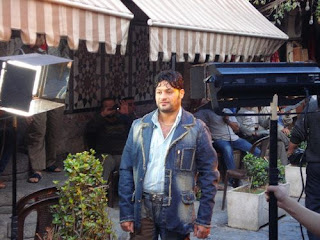

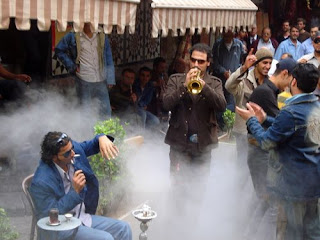
Monday 5 November 2007
Holy fools
What would you think about a man who climbed a fourteen meter high marble pillar because he wanted to be closer to God, and then stayed there at the top for the next forty years? I think most people nowadays would consider him mad but if you lived 1500 years ago you might sit below the pillar to listen to his wisdom, together with hundreds of others.
S:t Simeon the stylite did exactly this, we saw what is left of his pillar and the amazing ruins of the basilicas that surround it. These were erected after his death to his glory.
We camped outside the sight and in the evening had chamomile tea with the local guards and a Spanish man on his way to Jerusalem – by foot! It seemed appropriate to meet this pilgrim in such a place, and I couldn’t avoid making a comparison between the two men and their quests. José walks on average 35-40 km per day, every day for the last six months. It does seem like a kind of punishment of the body in the attempt to find some deeper meaning in life.
Asking the Muslim guards if they think S:t Simeon was crazy they strongly promoted the opposite. “Simeon was very holy man, very good man! He wanted to be close to God, that’s why he sat on the pillar. Very many people came to listen to him.”
According to the book The Street Philosopher and the Holy Fool the Islamic society has a different approach to madness than the western. People with mental disorders are considered closer to God, a thought that might have been more common in the medieval west but is now long gone.



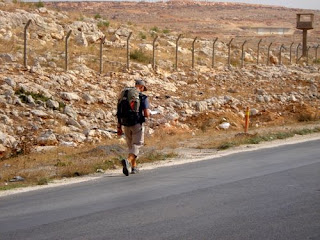
S:t Simeon the stylite did exactly this, we saw what is left of his pillar and the amazing ruins of the basilicas that surround it. These were erected after his death to his glory.
We camped outside the sight and in the evening had chamomile tea with the local guards and a Spanish man on his way to Jerusalem – by foot! It seemed appropriate to meet this pilgrim in such a place, and I couldn’t avoid making a comparison between the two men and their quests. José walks on average 35-40 km per day, every day for the last six months. It does seem like a kind of punishment of the body in the attempt to find some deeper meaning in life.
Asking the Muslim guards if they think S:t Simeon was crazy they strongly promoted the opposite. “Simeon was very holy man, very good man! He wanted to be close to God, that’s why he sat on the pillar. Very many people came to listen to him.”
According to the book The Street Philosopher and the Holy Fool the Islamic society has a different approach to madness than the western. People with mental disorders are considered closer to God, a thought that might have been more common in the medieval west but is now long gone.
Trapped in no mans land
We came to Syria! But not without some troubles first. Since Turkey is relatively expensive we decided to leave it a bit ahead of schedule. We exited Turkey through the very small border of Kassab on the 31st of October. Peter handed over his passport to the Syrians and got it stamped. For me it was not as easy, - we had forgotten something. After being scrutinized by the border police my passport was handed back without being stamped, my visa started on the first of November and was not valid yet.
So there we were, Peter only had single entry to Syria and had already officially entered, I couldn’t until the next day. So we took out our kitchen and cooked some spaghetti, played some cards, had coffee, smoked nargile with the men in uniform, who were very friendly, and went to sleep between the border posts.
Next morning the border police invited us for coffee before my visa was stamped and we could enter Syria after about eighteen hour in no mans land.
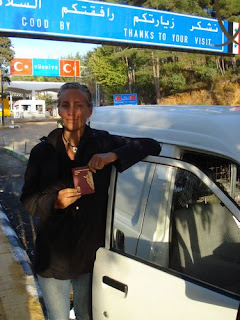
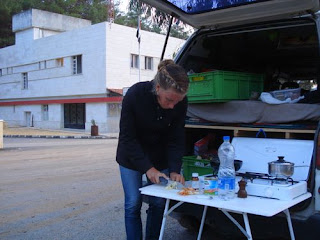
So there we were, Peter only had single entry to Syria and had already officially entered, I couldn’t until the next day. So we took out our kitchen and cooked some spaghetti, played some cards, had coffee, smoked nargile with the men in uniform, who were very friendly, and went to sleep between the border posts.
Next morning the border police invited us for coffee before my visa was stamped and we could enter Syria after about eighteen hour in no mans land.
Who works in Urfa?
Some delayed comments on Urfa: In Sanliurfa, besides holy fish and weird demonstrations, we saw some other things of interest. Walking the streets and the bazaar it was impossible not to notice all the kids and young people working. They are not only selling chewing gum and napkins on the street as they are everywhere east of Slovenia, here they seem more systematically put to labor. East of Turkey sure is Asia. We asked a local guy about the laws and he claimed there is no law about compulsory elementary school in Turkey – something that sounds very strange indeed. But even if school is compulsory and child labor is forbidden, it seems these things are not enforced in this very Kurdish part of the country.
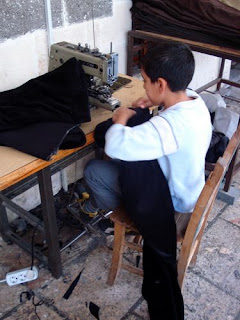



Subscribe to:
Posts (Atom)
